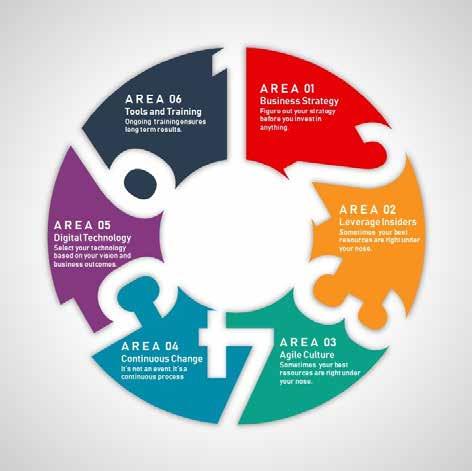
4 minute read
Are You Ready for a Digital Transformation?
from Success Champions
Are You Ready for a Digital Transformation? Tech Corner
Advertisement
We all realize the positive impact digital technology can have on our businesses and our lives. It can make our processes more efficient and give us greater insight into our clients. Normally in this column I introduce you to some cool tech tools that will do just that. But it is really easy for people and organizations to get overwhelmed by the neverending onslaught from the next “must-have” piece of software. But digital technology is here to stay, and so is the never-ending change that it brings with it. So, what’s the solution to successfully transform your business with digital technology? The answer is mindset. You need to have a growth mindset.
The idea of a growth mindset is not a new concept as it has been around for over three decades. But most people don’t understand what it is. A growth mindset is built on the belief that intelligence can be developed and that through effort, you can increase your intelligence and skills. The opposite is a fixed mindset where a person believes their intelligence is fixed and instead of developing them, they spend their time documenting their intelligence. Being trapped in a fixed mindset may slow down or, worse, completely derail the implementation of technology that can help your business grow.
The key to deploying a digital technology solution to your company is to remember that the technology is only half of the equation. People are the other half. You need to help them develop the growth mindset alongside you. Successful digital transformation is all about:
• Putting people at the center of everything you do
• Empowering members of your team to take risks and innovate
• Helping them view challenges and failures as an opportunity to learn
In a successful transformation there are 6 areas of focus.
1. Business Strategy. Figure out your strategy before you invest in anything. Often leaders that are looking to enhance efficiency of their organization will pick a tool and then apply it to their business rather than identifying their business strategy and identifying technology that helps them achieve their goal.

2. Leverage Insiders. Outside experts aren’t always the best solution. Often, they come predisposed with ideas packaged under the guise of best practices. Successful digital transformations involve insiders who have intimate knowledge of the daily happenings in their organizations and can help effectively adapt the technology to the overall business strategy
3. Agile Culture. The process of digital transformation is characterized by constant change; decisions are made provisionally, results tracked and then adjusted. Decisions need to be made quickly and representatives from all parts of the organization need to be involved. This means your typical hierarchy tends to slow things down. Utilizing a flat earth structure to oversee the digital transformation will allow people from different functions to review proposals and identify potential problems before they occurred.

4. Continuous Change. It is important to understand that digital transportation is not an event but a continuous process. Technology and your processes will continue to evolve and you need to maintain the growth mindset as new people enter your organization. Shared knowledge between cross function groups is key to sustaining constant change as your organization grows.
5. Digital Technology. It is important to select your digital technology based on your vision and desired business outcomes. Often times an organization can see better results utilizing two to three pieces of technology that have specialized functions and allow you to customize your process more fully than using a single piece of technology. The old saying, “A jack of all trades, a master of none” applies to software as well as people.

6. Tools and Training. It is important to provide training not only for current members of your organization but new members that join your team down the road. And it is important to remember not everyone learns the same way. Including multiple training techniques such as visual, experiential and gamification to ensure the best results for your organization.
They say the only constants are death and taxes, but with the onset of digital technology, change has become a new constant for business. Adaptability, agile thinking and taking ownership of that change is key to surviving that change. Start by establishing a growth mindset for you and your team that allows innovation and collaboration. It doesn’t happen overnight, but making small shifts over time will keep your team moving forward even in the face of technological disruption.
Kevin Snow is the founder of Time On Target, a digital marketing agency that helps businesses effectively use technology to grow their business. Kevin has helped companies all across the United States shorten their sales cycle and increase their closing rates by utilizing sales automation to increase the time sales teams are in front of prospects selling. You can reach Kevin at kevin.snow@time-on-target.com.











